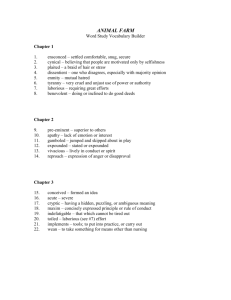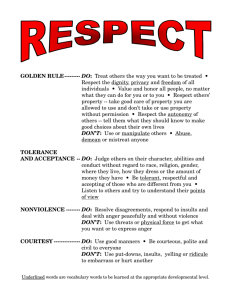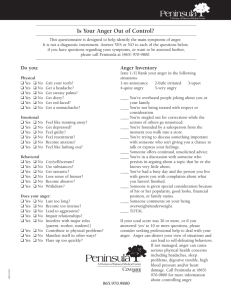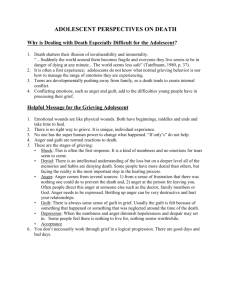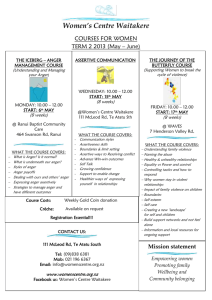Chapter 8: Develop Your Emotional Intelligence
advertisement
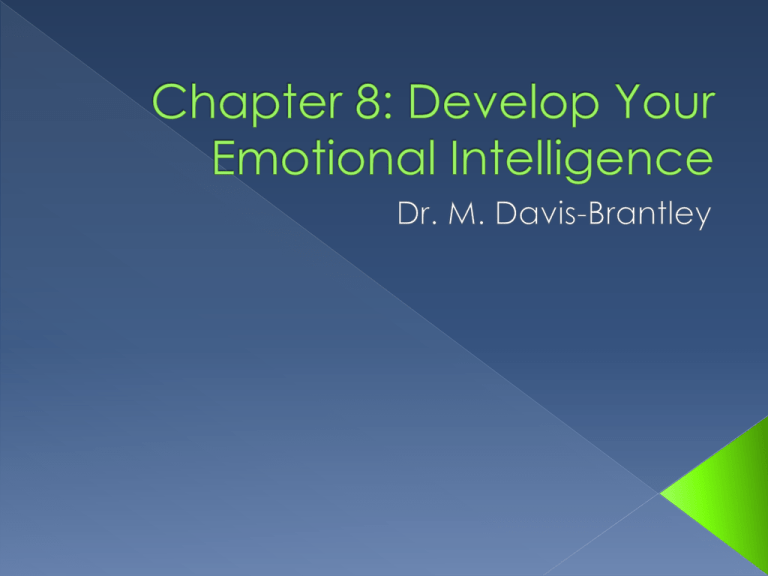
What is Emotional Intelligence? EQ vs. IQ IQ was said to be a predictor of success; on the contrary, IQ is a poor predictor of future success Valliant (1977) conducted research on Harvard graduates in the 1940’s and found: › Those with higher SAT scores tended to be less successful than their lower scoring counterparts with regard to career success, income, and interpersonal lives (based on marital satisfaction and quality of social life) Other researchers found that higher IQ also did not predict employment stability Researcher, Goleman reported that IQ only contributes about 20% to one’s success in life The other 80% has to do with one’s emotional intelligence Emotional Intelligence includes skills such as › Being able to motivate yourself › Persevere in the face of frustration › To delay gratification › To control your emotions › To empathize with others › Maintain a positive outlook What’s the difference between this and IQ? Intelligence End States Core Components Logical-Mathematical Scientist, Mathematician Capacity to discern logical or numerical patterns and the ability to handle long chains of reasoning Linguistics Journalist, Poet Sensitivity to the sounds, rhythm, and meanings of words and sensitivity to different functions of language Musical Composer, Musician, Producer Abilities to produce and appreciate rhythm, pitch, and timbre. Appreciation of the forms of musical expressiveness Spatial Navigator, Builder, Engineer Capacities to perceive the visual-spatial world accurately and to perform transformation on one’s initial perception Bodily-Kinesthetic Athletes, Dancers Abilities to control one’s body movements and to handle objects skillfully Interpersonal Therapists, Salespersons Capacities to discern and respond appropriately to the moods, temperaments, motivations, and desires of other people Intrapersonal Persons with detailed accurate self-knowledge: Nuns, Monks, etc… Access to one’s own feelings and the ability to discriminate among them and draw upon them to guide behavior, knowledge of own strengths, weaknesses, desires, and Gardner divided emotional intelligence into four components: › Leadership skills › Ability to make friends and nurture relationships › The ability to resolve conflicts › Emotional Perceptiveness Goleman divided EQ into five components Self-Awareness—which is the ability to know your own emotions Managing your emotions—the ability to master stress, control anger, overcome depression and anxiety, and remain optimistic 1. 2. › All of which are vital in recovering from life problems Self-motivation—the ability to persevere, to delay gratification and wait for rewards, and stay focused on a task especially those essential in most life endeavors and long-term goals Perceptiveness—the ability to perceive and correctly identify the emotions of others along with skill at recognizing how your behavior impact others Handling relationships—skill in relating to others and managing their emotions 3. 4. 5. › Involves listening skills, conversational skills, being able to resolve conflicts, and knowing how to be appropriately assertive Dependence—is the reliance on another for one’s needs Interdependence—is the relationship that ensues between two or more independent individuals who come together to achieve a common goal › They realize that working together can help them achieve more than the mere sum of their individual accomplishments › Healthy marriages, business partnerships, and friendships are characterized by interdependence Co-dependence—is when individuals depend on one another b/c they do not truly feel they can survive on their own › Rather than support one another’s growth, they create situations to ensure the co-dependency (Drama!!!) › Ex: The alcoholic husband and the co-dependent wife who says she wants her husband to stop drinking but continues to buy his alcohol › Ex: I hate my girlfriend and I will break up with her but continue to have unprotected sex with her (Which can lead to baby-mama or baby-daddy drama) Prisoner’s Dilemma Win-Win Outcomes Lose-Lose Outcomes Barriers to Win-Win Outcomes › Anger or resentment Getting wrapped up in your emotions › No Cooperation What is conflict resolution? › Useful guidelines used to resolve a conflict or disagreements with friends, loved ones, relatives, coworkers, etc… How might effective conflict resolution contribute to one’s personal effectiveness? Typically we use a very informal (and sometimes close-minded) approach to solving problems, which can lead to not having a resolution What are the steps to conflict resolution? Step 1: Acknowledge/Identify the Problem to Yourself Some conflict is an unavoidable part of life, but must be handled adequately or it can lead to other problems Step out of your shoes ad look at the situation and determine what the real problem is Understand Why? you are upset and own that the problem is yours so that you can be more effective in approaching the other party Step 2: Agree on a Date and a Procedure Don’t just confront the other person › Fights often ensue because one person confronts the other without the other person being ready at that moment Set up a meeting time that is convenient for both Make sure there is enough time allotted to deal with the issue Decide who will be in attendance of the meeting Step 3: Describe Your Problem and Your Needs Recognize that you begin creating a climate for either cooperation or contention from the moment negotiations begin Both parties are meeting because they have some shared interests › Ex: Your landlord will meet with you b/c she wants to keep you as a tenant State your position and your needs upfront › Using “I” statements, instead of “You” statements which may make the other person defensive and place blame Define the problem as a mutual problem to tap the motivation of all parties to seek a mutual agreement Manage your emotions appropriately Remember “Fight or Flight” Response Anger is an adaptive reaction when face with a perceived threat (e.g., tiger attacks us in the jungle) › Anger had survival value in the past › In today’s world physical confrontations are no longer useful in most situations Violent, unrestrained anger, has been the forefront of national headlines and at the core of many of most serious problems (e.g., 9/11 and school killings, what else???) Frustration-Aggression Hypothesis—frustration is a primary factor resulting in anger › Frustration is a result of being blocked from reaching a goal We learn anger from others An individual will exhibit anger and hostility based on seeing anger having been rewarded or modeled in their past. An individual may also not exhibit anger based on watching aggressive behaviors be punished Remember: Observational Learning? Research: 8y.o. boys who preferred violent games were likely to be aggressive as 18y.o. men Individuals are likely to engage in aggressive behavior if: › There is a previous history of violent behavior › Having been physically abused in childhood › Having witnessed violence in the home as a › › › › child A history of harming animals as a child Heavy exposure to violent TV programs or video games Absence of remorse over hurting others Family history of mental illness or violence Physiology of Anger Learning to control your anger Looking to others to blame for our anger Attribution Theory If humans are faced with physiological arousal of unknown origin, they will search their environment for an appropriate explanation or label for this arousal
